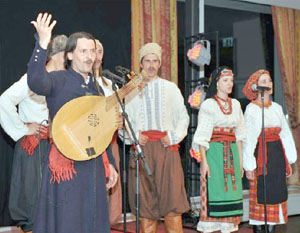A cultural discovery for Europe
Our artists present ancient, medieval, and modern Ukrainian art
May 3 through 12 Ukrainian artists acquainted four Swiss towns with little-known ancient, medieval, and more recent examples of Ukrainian culture. They also held five concerts: in Nottwil, Hochdorf, Bad Ragaz, and Bad Zurzach. These included performances by Kostiantyn Chechenia’s Band of Ancient Music, Nina Matviienko, Roman Hrynkiv’s jazz quintet, the folk dance and music band Vulytsia, Taras Kompanychenko and the band Khoreia Kozatska, as well as the duet of acrobats Popov and Shcherbak (Merited Masters of Sports of Ukraine, two-time world and European champions).
The tour was supported by the Widenmoos Business Club in Switzerland, while the art agency Art Veles was its Ukrainian sponsor. The Day was informed about this by Taras Hrymaliuk, Art Veles director, who directed the performance of the Ukrainian artists.
The concerts, which lasted almost three hours, comprised: mo-dern pieces based on Ukrainian folk themes in free jazz interpretation by the bandurist Roman Hrynkiv; jocular and lyrical medieval Ukrainian love chants, ancient carols; Hryhorii Skovoroda’s philosophical satirical song performed by Matviienko and the Chechenia Band of Ancient Music; jazz arrangements of traditional Ukrainian songs by the Hrynkiv quintet; a cycle of instrumental pieces by unknown authors of the mid-17th century, found in a manuscript at the library of Kyprian Zhokhovsky, Metropolitan of the Ukrainian Greek Catholic Church in Kyiv, and performed by Chechenia’s band; a hymn to the Virgin Mary, dating back to the 15th or 16th century, written at the court of the Ukrainian Ostroh princes; and a popular hymn from the times of national liberation wars under Bohdan Khmelnytsky, performed by Kompanychenko and Khoreia Kozatska.
“Above all, we wanted to show that Ukraine has ancient cultural traditions,” said Taras Hrymaliuk as he commented on the program of the concerts. “That is why we started with ancient music, unknown in Europe, which in Ukraine is the concern of a few enthusiasts like Chechenia or Kompanychenko. They spend hours in libraries and archives to search for these lyrics and sheet music, and eventually bring them back to life.
“Besides, we wanted to present Ukrainian folk music, which best shows the nation’s character and its philosophy of life, as well as modern jazz music with ethnic motives. Our two acrobats were quite a rarity for the Swiss audience, who admitted that they don’t have a circus or acrobatic performers of such a high level.”
Aside from the Ukrainian musicians and artists, their Swiss colleagues also took part in the concerts: Big Band conducted by Tomas Biazoto, Heu-obe-n-abe conducted by Professor Ernst Heller, and Paloma Wurth Jazz Band.
The Swiss public also saw a film about Ukraine, while our performers got acquainted with the local monuments of culture. They also met a Swiss MP Lieni Fueglistaller, head of the committee for science, education, and culture, and a member of the committee for financial issues.
“The Swiss were shocked by the performance of the Ukrainian artists, since what they know of Ukraine is either negative or nothing at all. Chornobyl, illegal immigrants… The only positive thing are the Klitschko brothers,” complained Hrymaliuk. “They know very little about Ukrainian culture and, frankly speaking, they aren’t very interested. Europeans have such a lot to choose from that they don’t feel they need look for something else. In this respect Ukraine is definitely disadvantaged, since it doesn’t have any channels to transmit its cultural wealth to Europe. Other countries make a good use of those channels by holding festivals, film shows, and organizing tours for their performers. Therefore this ‘Ukrainian mission’ was quite a revelation for Switzerland. For example, they couldn’t believe that the hymn to the Virgin Mary, performed a capella by Kompanychenko and Khoreia Kozatska, dated back to the 15th-16th centuries. They found it hard to believe that back then Ukraine might have such complex and beautiful polyphonic singing.”
The proceeds from the concerts will be directed to aid the Swiss Paraplegic Center in Nottwil, the Eurasia Heart Foundation (which trains surgeons from Eastern Europe, including those from Ukraine, Moldova, and Russia), and the Philip Neri Foundation (which supports aged circus artists from Eastern European countries).






